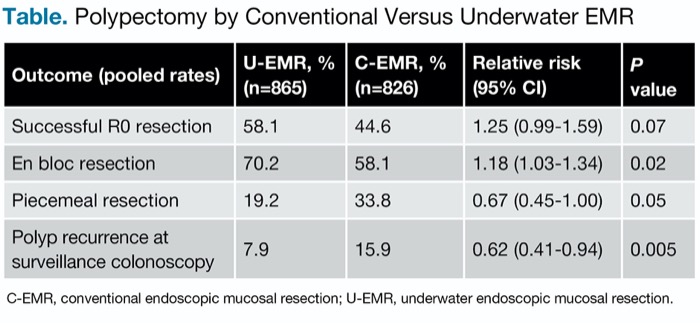CHICAGO—Underwater endoscopic mucosal resection has numerous advantages over the conventional approach for the resection of colorectal polyps, according to a meta-analysis presented at Digestive Disease Week 2023.
“We found that for all lesions, irrespective of their size, underwater endoscopic mucosal resection [U-EMR] outperforms conventional EMR [C-EMR] in terms of en bloc resection, R0 resection and rate of polyp recurrence,” said Saurabh Chandan, MD, an assistant professor of gastroenterology at Creighton University School of Medicine, in Omaha, Neb.
However, the data are less clear for lesions larger than 20 mm, he added. “I would say that U-EMR is comparable to C-EMR, and perhaps somewhat more favorable” in these instances, he said.
C-EMR has some important limitations, including high rates of polyp recurrence and low en bloc resection rates, especially for lesions smaller than 20 mm, Dr. Chandan said. U-EMR “has emerged as an alternative to conventional for colorectal polyps,” he said.
“One of its biggest advantages is that you do not need a submucosal lifting agent,” Dr. Chandan said, noting that such products can have unwanted effects on resected tissue samples. “All you need to do is to fill up the lumen with water and use electrocautery. There really is no learning curve.”
‘Newcomer Offers Better Results’
Dr. Chandan and his co-investigators conducted a systematic review and meta-analysis comparing outcomes of the two techniques, with data from prospective randomized controlled trials published up to November 2022 on R0, en bloc and piecemeal resection (abstract Sa1715). They also assessed pooled rates of polyp recurrence at surveillance colonoscopy, resection time, and adverse events including perforation and immediate and delayed bleeding.
The findings were based on seven randomized controlled trials involving 1,458 patients. Resections included 865 performed with U-EMR and 826 with C-EMR, of which 177 and 192, respectively, involved polyps larger than 20 mm.
The overall pooled rate of successful R0 resection was higher for U-EMR than C-EMR (58.1% vs. 44.6%), but this difference was of borderline statistical significance, Dr. Chandan said.
Of note, many other outcomes were significantly improved with this approach (Table). Overall pooled rates of perforation, immediate bleeding and delayed bleeding were similar between the approaches, as was resection time.
| Table. Polypectomy by Conventional Versus Underwater EMR | ||||
| Outcome (pooled rates) | U-EMR, % (n=865) | C-EMR, % (n=826) | Relative risk (95% CI) | P value |
|---|---|---|---|---|
| Successful R0 resection | 58.1 | 44.6 | 1.25 (0.99-1.59) | 0.07 |
| En bloc resection | 70.2 | 58.1 | 1.18 (1.03-1.34) | 0.02 |
| Piecemeal resection | 19.2 | 33.8 | 0.67 (0.45-1.00) | 0.05 |
| Polyp recurrence at surveillance colonoscopy | 7.9 | 15.9 | 0.62 (0.41-0.94) | 0.005 |
| C-EMR, conventional endoscopic mucosal resection; U-EMR, underwater endoscopic mucosal resection. | ||||
Although rates were better for U-EMR during en bloc resection, when the researchers pulled out the data for polyps larger than 20 mm, there was no significant difference between the techniques (relative risk, 1.24; 95% CI, 0.83-1.84; P=0.03).
Asked to comment on the findings, Felix W. Leung, MD, a professor-in-residence at the University of California, Los Angeles David Geffen School of Medicine, said new research is showing that U-EMR may be more successful in some cases. “C-EMR has a much longer history than U-EMR,” Dr. Leung said. However, in the past few years, randomized trials have compared these approaches, he said, yielding findings that suggest “the newcomer offers better results,” and the current meta-analysis “confirms that.”
There was a strong trend favoring U-EMR in achieving R0 resection, and the lack of statistical significance for this difference may be due to the overall small sample size, he suggested.
“Nonetheless,” Dr. Leung said, “long-term follow-up addressing the question of whether patients managed by U-EMR will have a lower rate of interval cancers deserves to be considered.”
—Caroline Helwick
Drs. Chandan and Leung reported no relevant financial disclosures.
This article is from the June 2023 print issue.






